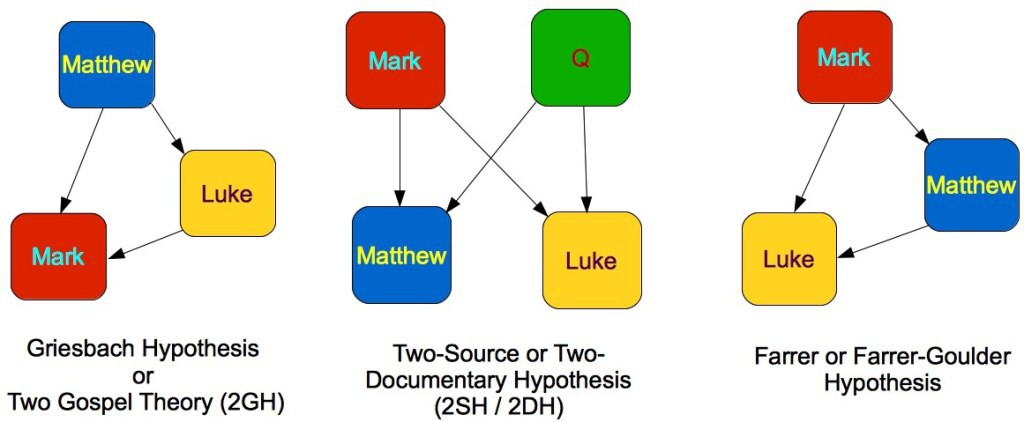Matthias Klinghardt in a recent article, The Marcionite Gospel and the Synoptic Problem: A New Suggestion, attempts to break through the deadlock between the Two-Source-Hypothesis and the Farrer-Goodacre-Theory by introducing into the debate a Gospel of Marcion that predates the gospels of Matthew and Luke. “The resulting model avoids the weaknesses of the previous theories and provides compelling and obvious solutions to the notoriously difficult problems.” (Klinghardt, p.1)
Here I share Klinghardt’s opening general arguments justifying the plausibility that Marcion’s gospel preceded canonical Luke.
1. “If Marcion altered Luke for theological reasons, he must have done so very poorly.” (p.7)
Tertullian scoffed at what he claimed was Marcion’s ineptitude for retaining in his “edited” gospel passages that refuted Marcion’s own teachings.
Now Marcion was unwilling to expunge from his Gospel some statements which even made against him–I suspect, on purpose, to have it in his power from the passages which he did not suppress, when he could have done so, either to deny that he had expunged anything, or else to justify his suppressions, if he made any. (Tert. AM 4.43.9)
Tertullian is not alone in quoting from Marcion’s text in order to refute him (also Epiphanius and Irenaeus). As a consequence we can to some extent make a reasonable attempt to construct the gist of Marcion’s gospel. (See )
Tertullian concluded that Marcion had failed to edit out so much material from his gospel that his gospel indeed supported his own anti-Marcionite teachings:
Marcion, I pity you; your labour has been in vain. For the Jesus Christ who appears in your Gospel is mine. (Tert. AM 4.43.9)
2. Tertullian accused Marcion edited canonical Luke, not pre-canonical Luke
Marcion claimed to have arrived at “his gospel” by studiously editing a corrupted original Pauline gospel. Tertullian, however, went on to claim that Marcion accused the catholics of corrupting “his gospel” in order to fit it in to the context of the Jewish Bible:
For if the Gospel, said to be Luke’s which is current amongst us (we shall see whether it be also current with Marcion), is the very one which, as Marcion argues in his Antitheses, was interpolated by the defenders of Judaism, for the purpose of such a conglomeration with it of the law and the prophets . . . . (Tert. AM 4.4.4)
Marcion is not here addressing Marcion’s assumed restoration of the original gospel but the editorial corruption of “his gospel” into the canon of the Old and New Testaments.
For it is certain that the whole aim at which he has strenuously laboured even in the drawing up of his Antitheses, centres in this, that he may establish a diversity between the Old and the New Testaments . . . . (Tert. AM 4.6.1)
Marcionites had claimed to be originally working from a Pauline gospel that needed editing, but that their gospel had then been taken over by their opponents and, with editorial additions, incorporated into the catholic canon.
In other words, Tertullian appears to be tacitly accepting (without wanting to agree with) Marcion’s charge that the catholics were indeed editing the “purified” Marcion gospel.
3. Was Marcion the unique exception in the way he edited texts?
“There is not a single example of a contemporary re-edition of an older text that did not support its editorial concept by including additional material. The supporters of the traditional view [that Marcion’s editing consisted only of deleting passages] have duly with great surprise noted the uniqueness of Marcion’s assumed redactoin but did not take this hint seriously enough to rethink their presuppositions.” (Klinghardt, p.9)
There is no evidence that Marcion at any time extended any passage or inserted any substantial additions to his gospel.
“With respect to what we know about editing older texts within the New Testament and its literary environment this procedure would be unique.” (Klinghardt, pp.8-9)
4. Significance of the anonymous prologue
If Marcion knew and edited canonical Luke, then it is reasonable to expect he knew other canonical gospels as well, and especially the Book of Acts.
So either
Marcion knew Luke-Acts but deleted the prologues and separated Acts from Luke, and rejected Acts completely. — This assumes that Luke-Acts was part of some early form of canon that preceded the Marcionite canon (unlikely in light of Harnack and Campenhausen),
Or
Marcion knew Luke-Acts as a 2 volume work but not as part of the New Testament, and chose only the gospel. — But this is unlikely since Luke and Acts are never found together in any of the manuscripts
The unity of Luke and Acts is thus indicated solely by the prologues which do not contain the author’s name,
“although this would be a nearly necessary genre requirement, at least for the first volume, in particular with respect to the pronounced historiographical “I” of Luke 1:1-4.” (Footnote to L. Alexander, SNTS.MS 78; 1993)
Thus for readers of an isolated 2 volume work Luke-Acts the identity of the author would remain a mystery.
Readers of the canonical edition would recognize Luke as the author of both because of the superscription of Luke (“Gospel According to Luke”) and — only if the prologue provided the link — Acts.
The assumption of Marcion priority offers an easy solution to the question: Marcionites were correct in their claim that their gospel had been incorporated into the catholic canon of Old and New Testaments by the interpolation of the superscription, with other editorial additions, and a feigned Luke-Acts unity.
5. The demonstrated editorial process
The differences between the texts of Marcion’s and Luke’s gospels are in many instances best explained as editorial additions by Luke rather than as abridgments by Marcion.
The most obvious cases are Luke’s re-editing and adding to the beginning of Marcion’s gospel (at Luke 3:1a), and the change of sequence of 4:31-37 and 4:16-30.
Most of Luke’s changes “add up to an integral and consistent concept”.
“The editorial concept that could not be detected in Marcion’s assumed editorial changes is apparent in Luke, thus confirming the view of Marcion being prior to Luke.” (p.10)
The bulk of Klinghardt’s article follows. This consists of a lengthy testing of the above leads with examinations of the Matthearn additions to the Triple Tradition not found in Luke; the special Matthew material not found in Luke; the alternating primitivity in double tradition material; Luke’s presumed reordering of Matthean material; the Minor agreements between Matthew and Luke within the triple tradition material. Kinghardt’s article concludes with a discussion of a new model to address the Synoptic Problem.
Like this:
Like Loading...


